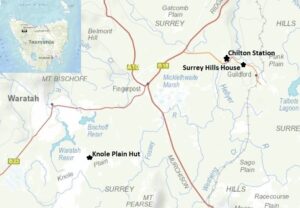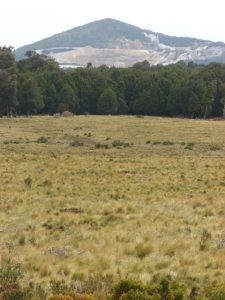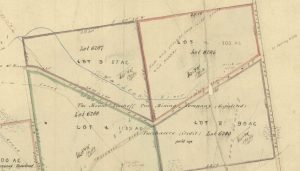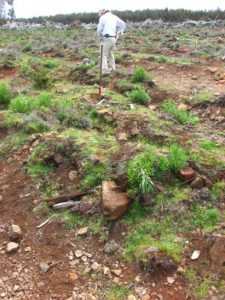The palm of being Waratah’s first alcoholic probably belonged to its first resident doctor, John Waldo Pring, a Crimean War veteran who drank himself to death in the years 1876–79.[1] One of his lowest moments came in March 1876 when he escorted a disguised detective to a sly grog shop for a snort.[2] Another who upset early Waratah’s temperance wagon was former Sussex labourer Charlie Drury (c1819–76), who traded native animal hides for rum. For decades before Waratah was born Drury lived a twilight existence remote from civilisation, with often only his dogs, his drink and the spirit world for companions. He even went out on a bender, leaving a legacy of decimated wildlife, delusional folklore and fire-managed grasslands to the hunters and graziers who followed him.

Transported at 20 on a fifteen-year sentence for larceny, the 178-cm tall Drury was no mal-nourished urchin.[3] James ‘Philosopher’ Smith rather generously called him ‘a sturdy type of an Englishman’.[4] Drury could read—books and newspapers were delivered to him in the back country—although no letters survive to testify to his fluency with the pen.[5] Arriving in Van Diemen’s Land in July 1839, he went straight into the assigned service of British pastoral enterprise the Van Diemen’s Land Company (the VDL Co) at the Surrey Hills, working with hutkeeper Edward Garrett and stockkeeper Richard Lennard (c1811–94).[6] The area between the Hellyer River and Knole Plain would be his home for most of his remaining life. His early services to the VDL Co were valued at only £15 per year (when he was stationed at Emu Bay 1845–46) but rose to £30, a typical stockman’s wage of the time, in the years 1850–52.[7] Hunting would have brought in much more than that.
Drury would have been thrown out of his official work when the VDL Co shut down all operations in 1852. He attended the Victorian gold rushes in February of that year, but would have returned to his old haunts after northern graziers the Field brothers (William, John, Thomas and Charles) rented the Surrey Hills in 1853, living chiefly off the proceeds of his unfettered hunting.[8] Of course he also had the gold ‘bug’, finding a little gold at Cattley Plain under the Black Bluff Range in 1857 or 1858.[9]
The old lag was joined at the Surrey Hills by fellow ex-convict Martin Garrett (aka Garrett Martin, c1806–88), who had racked up an impressive record of robbery in Dublin, bushranging in New South Wales and probation served at Port Arthur. Not bad for a dairyman![10] Both men took to hunting, with a little prospecting on the side.[11] Like other highland hunter-stockmen such as Jack Francis of Middlesex Plains, Drury had a little cottage industry going, his specialty being the whittling of celery-top-pine walking sticks manufactured on commission.[12] It would be surprising if he didn’t also make and sell possum-skin rugs, which could fetch £2 each. The two men lived in a surprisingly sumptuous eight-room house with a blacksmith’s shop, stable, out-houses and cattle yards about two kilometres east of the Hellyer River.[13] The cottage was designed for the VDL Co by none other than onetime colonial architect John Lee Archer—something of a comedown from his work on Parliament House and the treasured Ross Bridge.[14]
Drury’s twilight zone
Decades of isolation in the boondocks of failed VDL Co settlements may have taken their toll on Drury. Even well after the tribal Aboriginal people had been driven out of the north-west, the ‘ghosts’ of their clashes with the VDL Co and the isolation played havoc with him. The company’s old Chilton homestead up above the Hellyer River was said to be haunted by the spirits of murdered Aboriginals. Drury reputedly enjoyed being lulled to sleep there by ghostly ‘music’, until one night a more lively manifestation left him crouched in the fireplace with his gun drawn.[15]
Drury sold skins to his former VDL Co workmate and ex-convict Richard Lennard, who was now keeper of the Ship Inn at Burnie. Lennard would regularly bring a horse and dray up to Drury containing grog and rations, returning to Burnie with the skins. On one occasion when Lennard was arriving at Surrey Hills, Drury came out to meet him, calling out, ‘I know what you are going to tell me—Jack Flowers is dead.’ This referred to the ex-convict known as ‘Forky Jack’, a previous workmate, who had died recently. Lennard knew that Drury had had no contact with the outside world during that time, so how could he possibly know of Flowers’ death? ‘He passed over here’, Drury told him, calling ‘Charlie [distant], Charlie [loud], Charlie [distant]’—on his way to hell.[16] James ‘Philosopher’ Smith got the same story from Drury, who had heard Flowers calling him ‘in the most hasty manner possible while very quickly passing through the air’. The hallucination, if that is what it was, apparently occurred at about the time of Flowers’ death.[17]
Drury had other supernatural experiences/hallucinations and beliefs. One day he was out hunting not far from home when it came on dark. He sat down under a tree for a nap, intending to hunt badgers (wombats) when the moon rose. He was awoken by a clap on the shoulder and the words, ‘Charlie! Didn’t you say you were going to start out after the badgers as soon as the moon was up? Here it is more than three hands high’. The speaker, Drury told his friend William Lennard, wore a sleeved waistcoat and an English top hat. Drury gathered his dogs, including Long Jim, who his new friend pointed out to him a little way off, and as he did so the apparition ‘backed away through a swamp and faded out’.[18]
On another occasion Drury and William Lennard were camped at an isolated place called Sutelmans Park somewhere near Bonds Plain (east of the Vale of Belvoir). Come morning Drury declined to leave camp, having been warned by the banshee (a female Irish spirit who heralds death) during the night that some misfortune would befall him if he did so. Lennard persuaded Drury to disregard the warning, and they went out hunting with Drury’s favourite dog Turk. Later that morning they found the dog dead. ‘There you are’, Drury remarked, ‘what did I tell you?’ Drury then tried to bring the dog back to life by ‘wailing’ over it. Lennard recalled laughing at him for being so foolish, whereupon Drury ‘levelled his gun at him and threatened to blow his head off’. Realising the precariousness of his position, Lennard quickly came to his senses.[19]
In the early 1870s Drury’s unusual ways made it into an international travel book. When an 1871 party visited the Surrey Hills, Drury fed them cold beef, and the visitors got to try those famous possum-skin rugs, which, as was customary, were alive with fleas. While his guests battled these, Drury went badger hunting by the light of the moon with about a dozen kangaroo-dogs, bringing home three skins and one entire animal—presumably for breakfast. As he explained at the dining table, ‘the morning after I have been out badger-hunting at night I always eat two pounds of meat for breakfast, to make up for the waste created by want of sleep’. Drury also recalled his pack of ferocious hunting dogs falling in with a ‘flock’ of seven ‘hyenas’, four thylacines being killed at a time when, unfortunately for him, there was no government thylacine bounty.[20]
Drury and the Bischoff tin
Through the 1850s and 1860s the VDL Co was tantalised by reports of gold discoveries on or near its land. The company’s local agent, James Norton Smith, appears to have placed some faith in Drury as a potential gold discoverer, following his claim to have found gold at the Cattley Plain, and as late as 1872 offered him prospecting tools and discussed a reward for discovery of payable gold.[21]
Prospector James ‘Philosopher’ Smith got to know Drury, calling at his cottage in December 1871 when short of food after discovering one of the world’s greatest tin lodes at Mount Bischoff. Drury had seen Smith pass by on his way to Bischoff, and now expressed surprise that he was able to stay out in the bush so long. He also told Smith that he had no food—a statement that no doubt sent a shock wave through the enervated prospector. However, relief was at hand:
‘He [Drury] replied that what he meant was that he had no beef but had kangaroo, bread and tea. He hurriedly invited me into the house and commenced to prepare a meal with the utmost celerity. He slung a camp oven containing fat and then seized a chopper with one hand and a leg of kangaroo with the other and in a few minutes he had some of the meat frying while he also attended to the tea kettle.’[22]
Smith would have found accounts of this visit written long after his death harder to swallow. In 1908 and 1923 claims were made that Smith found the Mount Bischoff tin in Drury’s hut. ‘There’s a mountain of it just outside there’, Drury apparently told Philosopher, sending him a few metres to the summit of the mountain.[23] Why anyone who had been at Waratah in its early days, when Mount Bischoff was accessed via a tunnel through the horizontal scrub, would suggest the existence of a stockman’s hut in such a position it is hard to imagine.
Drury was the stuff of which disenfranchised prospectors are made, the bumpkin shepherd who stumbles upon a fortune. The strongest argument against the Drury discovery story—apart from his stock of hallucinations—is Smith’s unblemished reputation for integrity. The closest that Drury is likely to have got to the Bischoff scrub is the very edge, where the wallabies snoozed before making their way to the grassy plains at night to feed.
Protective of his father’s reputation and achievements, Garn Smith interviewed Jesse Wiseman and William Lennard, both of whom had hunted with Drury in the early 1870s. Both said that Drury never claimed to have found the Mount Bischoff tin.[24] Wiseman recalled Drury saying, ‘Just fancy us hunting about here all these times and not knowing anything about [the Mount Bischoff tin]‘.[25]
Yet other Drury acquaintances told a different story. An anonymous source claimed that ‘old Charlie Drury made no secret about telling travellers in those days that he directed Mr James Smith to where the tin was, he having a few specimens of this strange metal in his hut, which he showed to “Philosopher” Smith, who continued the quest …’[26]
Grazier John Bailey Williams was another to vouch for Drury, telling Lou Atkinson ‘I ought to have found Bischoff as Drury told me of the mineral, but I paid no attention to him. I had heard so many wild stories of this sort’.[27] Williams had encountered Drury while trying to run sheep in the open grasslands at Knole Plain in 1864–65.[28] His application to lease 6500 acres of Crown land there foundered, with many sheep reportedly starving to death.[29] Well might he have wished for a tinstone saviour!
However, it seems that wild stories were Drury’s stock in trade. It wouldn’t be at all surprising if the old sot had mineral samples in his hut—but it would be a great shock if they were cassiterite specimens.[30]
Opportunity knocks
The Mount Bischoff Tin Mine and its new trade route with Emu Bay brought financial opportunity to previously remote hunter-stockmen. Fields’ Hampshire Hills overseer Harry Shaw wanted to set up an ‘eating house’ along the road. [31] Garrett must have had similar commerce in mind when he tried to buy land at the Hampshire Hills.[32] He later drove the VDL Co Tram between Emu Bay and Bischoff and worked as a blacksmith at the Wheal Bischoff Co Mine.[33] Drury became a commercial operator. He and his mate John Edmunds established a base on the hunting ground of Knole Plain, leaving Garrett to hunt the Surrey Hills. Their hut stood right along the track to the mountain, on grasslands that the Mount Bischoff Tin Mining Company wanted to keep for feed for the bullock and horse teams carting between Waratah and the port at Emu Bay. They were professional hunters paying a £1 annual licence and returning up to £70 per season for shooting 600 to 1000 wallabies as well as the brush possums which formed their possum-skin rugs—at least that was told they told a visiting reporter.[34] The suggestion that such men obeyed government regulations is ludicrous. Additional money was to be had packing supplies for mining companies, as well as supplying Waratah with wallaby meat and some of the grog that they received from Emu Bay.[35] Feeding 20 kangaroo dogs alone would necessitate constant hunting.

The new trade route through to Emu Bay also gave hunters like Drury and Garrett better access to skin buyers—although their attempt to sell the skins of Drury’s beloved badger seems to have foundered. [36] While Garrett and Drury were out hunting, their charges—the Field brothers’ notoriously wandering cattle—wandered onto Waratah dinner plates, much to their owners’ disgust. In 1874 Thomas Field called for police intervention.
So did the Mount Bischoff Company when the first pub opened in town.[37] Drury’s unofficial pub never closed. One man was discharged from Walker and Beecraft’s tin claim for getting drunk there.[38] Drury himself was likely to get ‘on the spree’ at any time, making him an unreliable employee.[39] There was a celebrated incident in which Drury got hammered on a keg of rum and accidentally burned down his and Edmunds’ hut, destroying not only his own skins and stores but supplies belonging to prospectors Orr and Lempriere and surveyor Charles Sprent. The only thing salvaged was the keg, to which the hunter was said to have clung ‘with the affection of a miser’.[40]
Drink eventually killed Drury in his hut at Knole Plain. James Smith learned that:
‘His end was a melancholy one. He had been drinking somewhat heavily when two Christian men from Waratah went to see him at his hut … While talking to his new friends he lay down on his bed and seemed to doze but when after a time one of them tried to rouse him it was found that he was dead.’[41]


Finding Drury
Drury is said to have been buried beneath a eucalypt near his hut on Knole Plain.[42] Did anything remain there of either his hut or his grave? Examining an old map of Knole Plain more than a decade ago, Burnie surveyor and historian Brian Rollins found the notation ‘hut and kennels’. Brian was interested to find a James Sprent survey cairn that was marked on the same map. We resolved to combine our interests and, under the stewardship of Robert Onfray from Gunns, we made a trip to the Knole Plain area. We found ploughed remains of a long-fallen building which suggested Drury’s hut or some later version of it. No weathered cross tilted over the detritus. No bleached bones poked out of the furrows of the plantation coup. Perhaps Charlie Drury is six feet under the tussock grass, raising a toast with his insubstantial friends, his beloved dogs crashing through some underworld after twilit kangaroo, badger and tiger.
[1] ‘Mount Bischoff’, Devon Herald, 27 September 1879, p.2; he died of natural causes, 19 September 1879, inquest SC195/1/60/8154 (Tasmanian Archive and Heritage Office, afterwards TAHO), https://stors.tas.gov.au/SC195-1-60-8154, accessed 29 February 2020.
[2] ‘Sly grog selling at Mount Bischoff, Cornwall Chronicle, 27 March 1876, p.3.
[3] Drury was transported on the Marquis of Hastings. See his conduct record, CON31/1/12, image 31 (TAHO), https://stors.tas.gov.au/CON31-1-12$init=CON31-1-12p31, accessed 1 March 2020, also Description list, CON18/1/16, p.200 (TAHO), https://librariestas.ent.sirsidynix.net.au/client/en_AU/names/search/results?qu=charles&qu=drury#, accessed 23 February 2020.
[4] James Smith notes, ‘Exploring’, NS234/14/1/ 3 (TAHO).
[5] Cavanagh (?) to James Smith, 24 January 1875, no.38, NS234/3/1/4 (TAHO).
[6] VDL61/1/2 (TAHO). For Lennard see conduct record, CON31/1/27, image 179 (TAHO), https://stors.tas.gov.au/CON31-1-27$init=CON31-1-27p179, accessed 1 March 2020.
[7] VDL133/1/1 (TAHO).
[8] From Launceston to Melbourne on the City of Melbourne, 3 February 1852, POL220/1/1, p.558 (TAHO), https://librariestas.ent.sirsidynix.net.au/client/en_AU/names/search/results?qu=charles&qu=drury#, accessed 23 February 2020. Drury’s sentence expired in March 1853, leaving him free to choose his employer (‘Convict Department’, Launceston Examiner, 19 March 1853, p.6).
[9] See WR Bell, ‘Report on the hydraulic gold workings at Lower Mayday Plain …’, 14 May 1896, EBR13/1/2 (TAHO). In June 1858 a prospector W MacNab testing the Hampshire and Surrey Hills for gold complained that a mining cradle he expected to use had been removed for use by a stockkeeper from the Surrey Hills Station. See W MacNab to James Gibson, VDL Co agent, 9 June 1858, VDL22/1/2 (TAHO).
[10] See his conduct record, CON39/1/2, p.334 (TAHO), https://librariestas.ent.sirsidynix.net.au/client/en_AU/all/search/results?qu=Martin&qu=garrett, accessed 23 February 2020. After a stint in the New Town Invalid Depot (admitted 24 November 1886 to 17 December 1886, POL709/1/21, p.207) Garrett died of ‘dropsy’ (oedema, fluid retention) in Launceston in 1888 when he was said to be 82 years old (2 December 1888, death record no.391/1888, registered in Launceston, RGD35/1/57 [TAHO]).
[11] Garrett may have discovered the barytes deposit at the Two Hummocks near Fields’ Thompsons Park Station (James Smith to Ritchie and Parker, 10 July 1875, no.327, VDL22/1/4 [TAHO]).
[12] Richard Hilder, ‘The good old days’, Advocate, 5 January 1925, p.4; Charles Drury to James Norton Smith, 24 July 1872, VDL22/1/4 (TAHO).
[13] ‘Country news’, Tasmanian, 30 August 1873, p.5; G Priestley, ‘Search for Mr D Landale’, Weekly Examiner, 11 October 1873, p.19.
[14] Agreement between the VDL Co and builder George Fann, 4 March 1851, VDL19/1/1 (TAHO). Fann was paid £150 for the job on 19 April 1852 (VDL133/1/1, p.153 [TAHO]). Archer sent two designs for a stockkeeper’s hut to James Gibson on 17 February 1851, although unfortunately the designs cannot be found on file (VDL34/1/1, Personal letters received by James Gibson [TAHO]). See also the 1842 census record for Richard Lennard, who was then living at the VDL Co’s old Chilton homestead. He was one of ten men from the ages of 21 to 45 resident there at the time, only one of whom arrived in the colony free, while another qualified under ‘other free persons’. Two who were in ‘government employment, six in ‘private assignment’. Two were ‘mechanics or artificers’, two were ‘shepherds or others in the care of sheep’, five were ‘gardeners, stockmen or persons employed in agriculture’ and one was a ‘domestic servant’ (CEN1/1/8, Circular Head, p.63 [TAHO], https://librariestas.ent.sirsidynix.net.au/client/en_AU/all/search/results?qu=richard&qu=lennard, accessed 1 March 2020).
[15] William Lennard, quote by RS Sanderson, ‘Discovery of Tin at Mount Bischoff’, RS Sanderson to Arch Meston, May 1923?, M53/3/6 (Meston Papers, University of Tasmania Archives, Hobart).
[16] William Lennard, quoted by RS Sanderson, ‘Discovery of Tin at Mount Bischoff’.
[17] James Smith notes, ‘Exploring’, NS234/14/1/ 3 (TAHO).
[18] William Lennard, quoted by RS Sanderson, ‘Discovery of Tin at Mount Bischoff’.
[19] William Lennard, quoted by RS Sanderson, ‘Discovery of Tin at Mount Bischoff’.
[20] Anonymous, Rough notes of journeys made in the years 1868, ’69, ’70, ’71, ’72 and ’73 in Syria, down the Tigris … and Australasia, Trubner & Co, London, 1875, pp.263–64.
[21] James Norton Smith to VDL Co Court of Directors, Outward Despatch 38, 15 May 1872, p.482, VDL1/1/6; James Norton Smith to Charles Drury, 12 June 1872, p.493, VDL7/1/1 (TAHO).
[22] James Smith notes, ‘Exploring’, NS234/14/1/ 3 (TAHO).
[23] ‘Patsey’ Robinson, quoted in ‘The oldest inhabitants’, Zeehan and Dundas Herald, 24 April 1908, p.2.
[24] GH Smith, ‘The true story of Bischoff’, Advocate, 1 May 1923, p.6.
[25] Jesse Wiseman quoted by RS Sanderson, ‘Discovery of tin at Mount Bischoff’.
[26] ‘1866’, ‘Discovery of tin at Mount Bischoff’, Advocate, 30 April 1923, p.6.
[27] John Bailey Williams, quoted by RS Sanderson, Discovery of Tin at Mount Bischoff’.
[28] John Bailey Williams to Charles H Smith, Du Croz & Co, 25 January 1865; and to VDL Co agent Charles Nichols, 11 April 1865, VDL22/1/3 (TAHO).
[29] Thomas Barrett to R Symmons, 2 March 1867, VDL22/1/3 (TAHO).
[30][30] Thomas Broad claimed to have seen tin specimens in Drury’s hut—but did Broad have enough expertise in mineralogy to make that call? See Thomas Broad, ‘Mt Bischoff’s early days’, Advocate, 3 May 1923, p.2.
[31] James Smith to Ferd Kayser, 15 January 1876, NS234/2/1/2 (TAHO).
[32] James Smith to Martin Garrett, 30 June 1875, no.310, NS234/2/1/2 (TAHO).
[33] Hugh Lynch to James Norton Smith, 23 April 1877, VDL22/1/5; Daniel Shine to James Norton Smith, 27 October 1879, VDL22/1/7 (TAHO).
[34] ‘Country news’, Tasmanian, 30 August 1873, p.5.
[35] For packing, see WR Bell to James Smith, 20 July 1875, no.335; and Joseph Harman to James Smith, 11 October 1875, no.450, NS234/3/1/4 (TAHO).
[36] AM Walker to James Smith, 11 February 1873, no.115, NS234/3/1/2 (TAHO).
[37] Minutes of directors’ meetings, Mount Bischoff Tin Mining Company, 7 September 1875, NS911/1/1 (TAHO).
[38] Mary Jane Love to James Smith, 12 October 1873, no.290/291, NS234/3/1/2 (TAHO).
[39] William Ritchie to James Smith, 9 March 1874, NS234/3/1/3 (TAHO).
[40] ‘Trip to Mount Bischoff’, Mercury, 18 December 1873, p.3.
[41] James Smith notes, ‘Exploring’, NS234/14/1/ 3 (TAHO). Drury died 3 March 1876, death record no.151/1876, registered at Emu Bay, RGD35/1/45 (TAHO), https://librariestas.ent.sirsidynix.net.au/client/en_AU/names/search/results?qu=charles&qu=drury#, accessed 23 February 2020. Cause of death was given as ‘excessive drinking’.
[42] ‘An Old Hand’, ‘The O’Malley and the Labor Movement in Tasmania’, Zeehan and Dundas Herald, 28 May 1908, p.2.